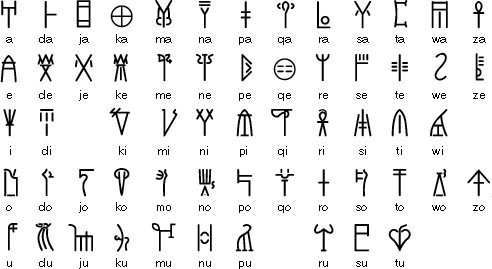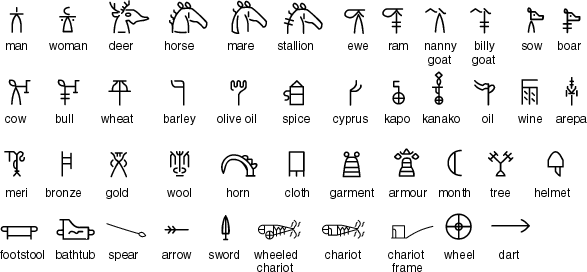Evans spent the rest of his life trying to decipher the inscriptions, with only limited success. He realised that the inscriptions represented three different writing systems: a 'hieroglyphic' script, Linear A and Linear B.
The hieroglphic script appears only on seal stones and has yet to be deciphered. Linear A, also undeciphered, is thought to have evolved from the hieroglyphic script, and Linear B probably evolved from Linear A, though the relationship between the two scripts is unclear.
Evans figured out that short lines in Linear B texts were word dividers. He also deciphered the counting system and a number of pictograms, which led him to believe that the script was mainly pictographic. Evans also discovered a number of parallels between the Cypriot script, which had been deciphered, and Linear B. This indicated that the language represented by Linear B was an ancient form of Greek, but he wasn't prepared to accept this, being convinced that Linear B was used to write Minoan, a language unrelated to Greek.
In 1939, a large number of clay tablets inscribed with Linear B writing were found at Pylos on the Greek mainland, much to the surprise of Evans, who thought Linear B was used only on Crete.
Michael Ventris (1922-56) was the person who eventually deciphered Linear B in 1953. His interest was sparked in 1936 on a school trip to an exhibition about the Minoan world organised by Arthur Evans. For the next 17 years, Ventris struggled to understand Linear B. At first he was sceptical that the language of Linear B was Greek, even though many of the deciphered words resembled an archaic form of Greek. Later, with the help of John Chadwick, an expert on early Greek, he showed beyond reasonable doubt the Linear B did indeed represent Greek.
Linear B was used between about 1500 and 1200 BC to write a form of Greek known as Mycenaean, named after Mycenae, where Agamemnon is said to have ruled. It . The Linear B inscriptions, most of which were accounting records listing materials and goods, are the earliest known examples of written Greek.
Linear B syllabary

Linear B logograms
These logograms stand for whole words and mainly represent items that were traded. As Linear B was used mainly for recording transactions, this is not surprising. Some of the logograms resemble the things the represent, so could be called pictograms. Not all the logograms have been deciphered.
Links
Information about Linear Bhttp://en.wikipedia.org/wiki/Linear_B
http://www.ancientscripts.com/linearb.html
http://linearbknossosmycenae.wordpress.com
Linear B inscriptions from Knossos
http://minoan.deaditerranean.com/linear-b-transliterations/
Linear B, Knossos & Mycenae
http://linearbknossosmycenae.wordpress.com/
Free Linear B fonts
http://www.csupomona.edu/~jcclark/fonts/
http://greekfonts.teilar.gr
ALPHABETUM - a Unicode font
specifically designed for ancient scripts, including classical
& medieval Latin, ancient Greek, Etruscan, Oscan, Umbrian,
Faliscan, Messapic, Picene, Iberian, Celtiberian, Gothic, Runic,
Old & Middle English, Hebrew, Sanskrit, Old Nordic, Ogham,
Kharosthi, Glagolitic, Old Cyrillic, Phoenician, Avestan, Ugaritic,
Linear B, Anatolian scripts, Coptic, Cypriot, Brahmi, Old Persian cuneiform:
http://guindo.pntic.mec.es/~jmag0042/alphabet.html








.jpg)



.jpg)
.jpg)





0 comments:
Post a Comment
Note: Only a member of this blog may post a comment.